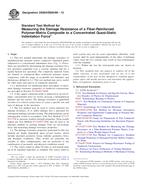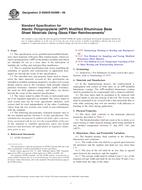Wir benötigen Ihre Einwilligung zur Verwendung der einzelnen Daten, damit Sie unter anderem Informationen zu Ihren Interessen einsehen können. Klicken Sie auf "OK", um Ihre Zustimmung zu erteilen.
ASTM D5117-09
Standard Test Method for Dye Penetration of Solid Fiberglass Reinforced Pultruded Stock
Automatische name übersetzung:
Standard Test Method for Dye Eindringen von Festplatten Fiberglass Verstärkt Pultrudierte Lizenz
NORM herausgegeben am 1.9.2009
Informationen über die Norm:
Bezeichnung normen: ASTM D5117-09
Anmerkung: UNGÜLTIG
Ausgabedatum normen: 1.9.2009
SKU: NS-29898
Zahl der Seiten: 3
Gewicht ca.: 9 g (0.02 Pfund)
Land: Amerikanische technische Norm
Kategorie: Technische Normen ASTM
Kategorie - ähnliche Normen:
Die Annotation des Normtextes ASTM D5117-09 :
Keywords:
dye penetration test, pultruded rod, rod stock, wicking, Composite plastic materials/applications, Dye penetrant inspection, Fiberglass-reinforced plastics (FRP), Flaw detection, Pultruded plastic rod stock, Resins, Rod stock, Structural integrity, Structural plastics, Ultraviolet (UV) analysis--plastics, Wick test, ICS Number Code 83.120 (Reinforced plastics)
Ergänzende Informationen
| Significance and Use | ||||||
|
This test method is useful for establishing the integrity of composite rod. The presence of voids, cracks, and hollow fibers are considered detrimental to the structural integrity of the composite and may cause reduced electrical resistance and increased current leakage. A perfect composite would be flaw-free, and there would be no possibility of wicking. Composites of this type are virtually nonexistent, as there will typically be entrapped air in the resin developed during manufacture, occasional hollow fibers, and occasional cracks due to thermal stresses. This test method is intended to provide a tool for measuring the extent of wicking in a composite over very short lengths of material for comparative purposes. The presence of wicking over 1 in. (2.54 cm) lengths may not necessarily imply that the composite will perform unsatisfactorily for its intended end-use. Therefore, interpretation of test results should be made with care. This test method was developed as a technique for estimating quality and consistency of pultruded rod and bar stock, which is a composite of resin and all-roving reinforcement. The manufacturing process may also affect the quality of the product. It should be useful for a manufacturer in determining whether any gross changes in quality have taken place due to process or raw material changes. Since the results of this test are so sensitive to sample size, penetrant type, penetrant used, viscosity, duration of test, and other factors, no attempt to arrive at or recommend development of a specification for these materials has been made. It is suggested that such a specification should be negotiated between supplier and end user. |
||||||
| 1. Scope | ||||||
|
1.1 This dye-penetrant test method covers a means of evaluating solid fiberglass all-roving reinforced pultruded rod or bar stock for longitudinal wicking. There are generally three mechanisms that promote wicking, any or all of which may be operating at a given time. Note 1—The specimen's cross-section may reflect delaminations, longitudinal continuous voids, or the presence of hollow fibers, or all three. Occasionally these flaws may be detected by this test, but other tests are usually required. 1.2 The results of a wicking test are dependent on specimen type and size, penetrant type, time of exposure in the penetrant, penetrant viscosity, etc. Any attempt to use a wicking test to establish specification criteria should be made with great care. 1.3 The values stated in either SI units or inch-pound units are to be regarded separately as standard. The values stated in each system may not be exact equivalents; therefore, each system shall be used independently of the other. Combining values from the two systems may result in nonconformance with the standard. 1.4 This standard does not purport to address all of the safety concerns, if any, associated with its use. It is the responsibility of the user of this standard to establish appropriate safety and health practices and determine the applicability of regulatory limitations prior to use. For specific hazard statements, see 10.3 and 10.6. Note 2—There is no known ISO equivalent to this test method. |
||||||
| 2. Referenced Documents | ||||||
|
Ähnliche Normen:
Historisch
1.4.2012
Historisch
1.10.2013
Historisch
1.8.2012
Historisch
15.5.2014
Historisch
15.2.2009
Historisch
1.10.2013



 ASTM D6264/D6264M-12..
ASTM D6264/D6264M-12.. ASTM D6415/D6415M-06..
ASTM D6415/D6415M-06.. ASTM D6416/D6416M-01..
ASTM D6416/D6416M-01.. ASTM D6484/D6484M-14..
ASTM D6484/D6484M-14.. ASTM D6509/D6509M-09..
ASTM D6509/D6509M-09.. ASTM D6671/D6671M-13..
ASTM D6671/D6671M-13.. Cookies
Cookies
